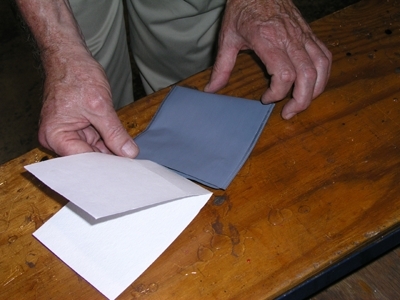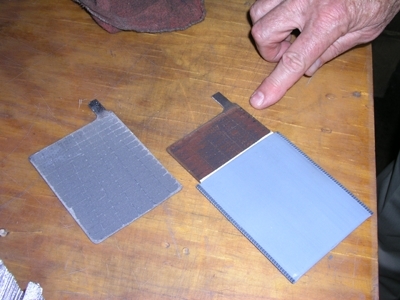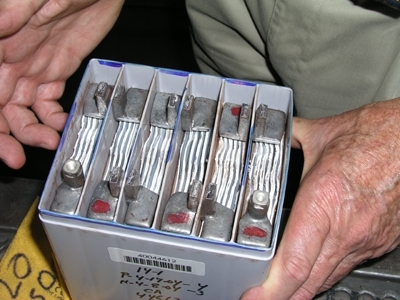nuckolls.bob(at)aeroelect
Guest
|
 Posted: Tue Jun 30, 2009 12:21 pm Post subject: Battery facts and myths redux . . . Posted: Tue Jun 30, 2009 12:21 pm Post subject: Battery facts and myths redux . . . |
 |
|
Since this topic seems to be simmering again on the list,
I thought it would be useful to share an excerpt from another
conversation concerning battery characteristics and performance:
| Quote: | It is my understanding that a battery can fail in only one of three ways (modes):
1. An internal short circuit that results in a direct closed path from the (+) to the (-) terminals. |
Never happens. Single cells might short thus
reducing a 12v battery to a 10v battery. This
causes the system to respond by overcharging
what it perceives is a seriously discharged
12v battery. Failure of other cells due to
overcharging is the secondary effect.
| Quote: | | 2. An internal open circuit that results in no path between the (+) and (-) terminals. |
Yes . . . but very rare. Usually due to manufacturing
defect.
| Quote: | | 3. An internal resistence (I beleive this is correct) that results in the inability of the battery to provide power/accept a charge, but not 1 and 2. |
All power sources have internal resistance. This
is inherent in any "non-perfect" device. The
resistance may be quite low (typically 10 milliohms
for a small 12v RG battery) but rises with time
as cell-stes in the battery begin to die off.
A battery that is ready to be replaced due to
loss of capacity might expect to see a 30-40%% increase
or so in internal resistance. Still capable of
cranking an engine but not capable of meeting
endurance mode requirements. This would not be
classed as a failure but an end of life event.
| Quote: | Open Circuit (#2):
A. For two batteries: It would not affect the second parallel battery. The only effect on the system would be to reduce capacity by the failed battery's contribution. |
Yes.
| Quote: | | B. For a single battery: The effect on the system would be the same as no battery. If the alternator were running, power would continue to be provided subject to the conditions that would take the alternator off line, at which time no power would be provided. Otherwise no power would be provided. |
Yes.
| Quote: | Internal Resistance (#3):
A. For two batteries: It would not effect the second parallel battery. The effect on the system would be to reduce capacity by the failed battery's contribution, in some proportion to the increase in resistance. In other words, the failed battery would not drain energy from the second battery. |
Yes.
| Quote: | | B. For a single battery: The effect on the system would be to reduce capacity in some proportion to the increase in resistence. At some point the capacity would be reduced to below that necessary to keep the alternator on line, at which time no power would be provided. |
Demonstrated internal resistance would/should
never be allowed to degrade to a "no power"
condition. This is a service life issue that
should be addressed as a preventative maintenance
program on the airplane.
| Quote: | Short Circuit (#3):
A. For two batteries: It would cause an immediate drain on the second parallel battery. |
Yes.
| Quote: | | With no means to isolate the failed battery it would cause a failure of the two battery system. |
The OK battery would not be at risk but its
stored energy would combine with alternator output
to overcharge the 10v battery.
| Quote: | | If the alternator were running, and the failed battery system were not isolated, the drain on the whole system would excede the alternator capacity and the whole system would fail. |
No, the alternator MIGHT go into current limited
operation at the 10V level but in a matter of
minutes, overcharged cells in the failed battery
would outgas, their internal resistance would rise
and the failure would essentially isolate itself
over time. This presumes of course that the battery
has a demonstrated ability to go into passive failure
under severe overcharge conditions. Batteries qualified
for military and aircraft use are subjected to such
tests in the lab. It's likely that even a commercial
off the shelf product would be similarly disposed to
go quietly off into the sunset.
| Quote: | | If the failed battery system were isolated, it would have the same effect as no battery except that it is probable that the alternator would be off line due to reduced system voltage at the time of isolation and the whole system would be failed. |
No. As long as the bus voltage stays above one volt
or so, the alternator never "quits". In the shorted
cell case, there's no reason to expect bus voltage to
drop below 10-11 volts while being feed by the
alternator. If the battery is well behaved in the
shorted cell scenario, then I would expect the low
voltage condition to last perhaps 30 minutes before
the failed battery unhooks itself.
| Quote: | | B. For a single battery: It would have the same effect as A. for the failure of the two battery system. |
For a single battery, single shorted cell, the system
voltage would depress to 11 or so volts and the combined
output of alternator and battery would go to work boiling
of the liquid in the remaining good cells. Passive
disconnect followed by return to normal bus voltage
would be expected.
| Quote: | III. Detection (assuming a system volt meter and alternator load meter)
Opern Circuit (#2) and Internal Resistance (#3):A. For two batteries: At start up, it might be detectable as reduced or insufficinet cranking capactiy. In flight, it would not be detectable as long as the alternator was functioning and loads were below the alternator capacity. If loads exceeded alternator capacity, it might be detectable by a greater than expected drop in system voltage in relation to load. If the alternator failed, it would be detectable by a greater than expected drop in system voltage in relation to load. |
If the alternator is on line, bus is supported at
the setpoint votlage and low voltage warning would
be dark. If the alternator goes off line, then
the bus would still fall to the expected 12.5 or so
volts and decay from there depending on load. The
low voltage warning light would be ON but you would
obviously not have access to the expected capacity
of both batteries. This would take some time to
discover when expected endurance performance falls
short by about 1/2.
| Quote: | B. For a single battery: At start up it would be detecable as zero or insufficient cranking capacity. In flight, basically the same as A except that the drop in system voltage would be more severe and detectable, and with the alternator failed, the there woul be no power under #2.
It that understanding correct?? |
Essentially
| Quote: | Short Circuit (#1):
A. For one and two batteries: It would be detectable as an immediate drop in system voltage and if not isolated immediately, failure of the whole system. Even if isolated immediately, it is probable that the whole system would be failed due to the initial drop in system voltage taking the alternator off line. |
No, a shorted cell doesn't take the
whole system down. There would be a
momentary drop in voltage probably
annunciated by low voltage warning
and paired with alternator loadmeter
showing a maxed out machine. But as
the still functioning cells are cooked
off, voltage would rise and the alternator
output would drop back to the value
demanded by system loads.
Probability of cell shorting is exceedingly
low because the typical RG battery has
physical barriers of porous plastic and/or
glass mat fiber between plates . . .
[img]cid:7.1.0.9.0.20090630150713.01e78470(at)aeroelectric.com.0[/img]
[img]cid:7.1.0.9.0.20090630150713.01e78470(at)aeroelectric.com.1[/img]
[img]cid:7.1.0.9.0.20090630150713.01e78470(at)aeroelectric.com.2[/img]
As you can see in these views on a Concorde RG
battery, alternate plates are completely bagged
in fiberglas and plastic. No shorted cells in
this product.
All of these hypothetical failures presume that
an alternator is sufficiently cooled to tolerate
current limited operation for a period of time.
They also presume benign response to overcharging
that is demanded of batteries qualified to
aviation and military service.
Bob . . .
| | - The Matronics AeroElectric-List Email Forum - | | | Use the List Feature Navigator to browse the many List utilities available such as the Email Subscriptions page, Archive Search & Download, 7-Day Browse, Chat, FAQ, Photoshare, and much more:
http://www.matronics.com/Navigator?AeroElectric-List |
|
| Description: |
|
| Filesize: |
92.78 KB |
| Viewed: |
951 Time(s) |

|
| Description: |
|
| Filesize: |
95.28 KB |
| Viewed: |
951 Time(s) |

|
| Description: |
|
| Filesize: |
108.21 KB |
| Viewed: |
951 Time(s) |

|
|
|





